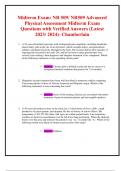Exam (elaborations)
Midterm Exam: NR 509/ NR509 Advanced Physical Assessment Midterm Exam Questions with Verified Answers (Latest 2023/ 2024)- Chamberlain
- Institution
- Chamberlain College Of Nursing
Midterm Exam: NR 509/ NR509 Advanced Physical Assessment Midterm Exam Questions with Verified Answers (Latest 2023/ 2024)- Chamberlain 1. A 42-year-old architect presents with widespread pain complaints, including headaches almost daily, pain at the site of an old motor vehicle accident injury, ...
[Show more]




